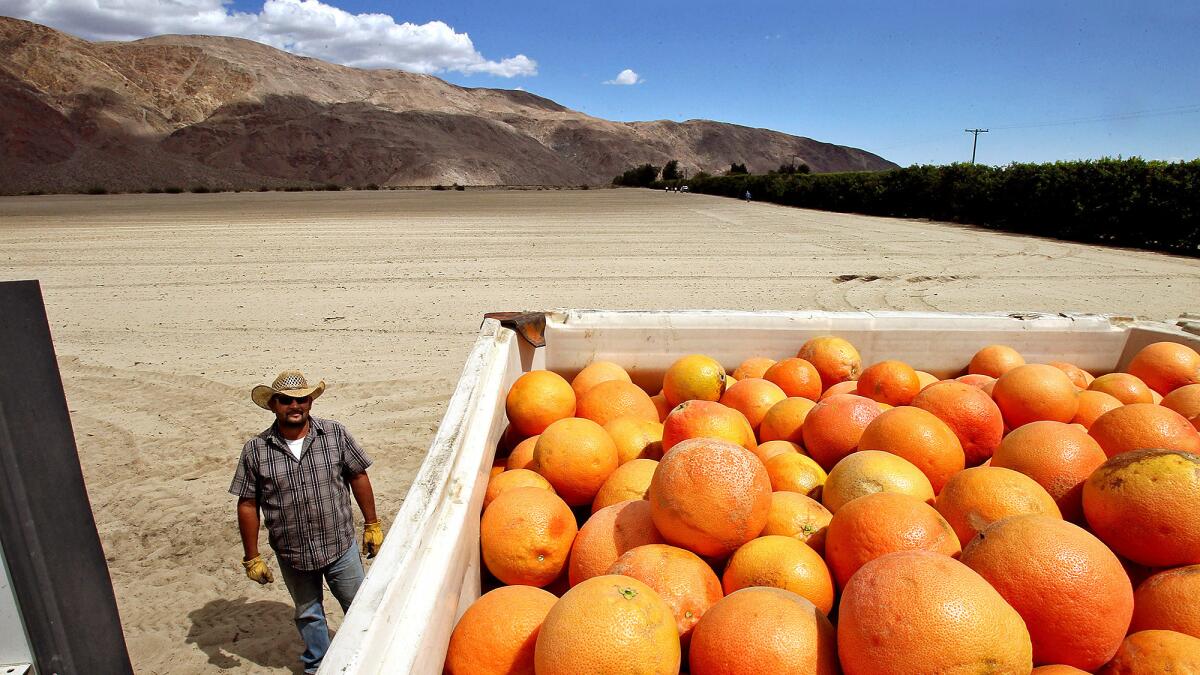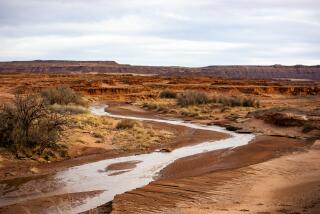Defeat of water bond measure bodes disaster for the desert community of Borrego Springs

- Share via
Reporting from San Diego — It’s back to square one for the tiny desert community of Borrego Springs, which is facing the daunting task of reducing its consumption of water by at least 75% in the coming decades.
The defeat of Proposition 3, an $8.8-billion state water bond, in the Nov. 8 election was a crushing blow. The bond lost 51.5% to 48.5%
Had it passed, Borrego Springs would have received $35 million to fallow most of the 3,800 acres of citrus and other farms in the northern part of the community.
The farms would have been purchased, the trees cut down, and the land eventually would have become part of the huge Anza-Borrego Desert State Park, which surrounds the unincorporated town like a doughnut.
Those farms, some in existence for more than for 50 years, have been sucking between 70% and 80% of the groundwater from the town’s lone aquifer. Golf courses, businesses and residents use the rest.
There’s no way to pipe water into the Borrego Valley. It’s groundwater or nothing.
At stake is the very future of the community of about 4,000.
In 2016, the state passed the Sustainable Groundwater Management Act and classified Borrego’s sole-source aquifer as being in critical overdraft, the most serious level.
The community, led by a group comprised of members of the Borrego Water District and the San Diego County, are charged with coming up with a draft plan by early next year to slash water consumption by the year 2040. The aim is to bring the aquifer into equilibrium with the amount of water that naturally replenishes the basin annually.
In other words, the inflow and the outflow need to become the same, as Borrego Water District General Manager Geoff Poole explained at a community meeting last week.
Early on, it was clear that the only way to make that happen was to shut down most or all of the citrus and palm farms in the valley. That must still happen, but how to do it, while being fair to the property owners and those who work on the farms, is a matter that Proposition 3 would have gone a long way to solve.
“Everyone hoped it was going to be a silver bullet to provide money to buy out farmers,” said Dave Duncan, who has been a part of a group of people working on a sustainability plan and who will become a member of the water board in December.
Even with the farms gone, residents and other businesses in Borrego Springs will still feel the impact of the reductions.
Meanwhile, as was evidenced at the overflow community meeting, people are terrified about the future.
Some say they already feel the effects of the pending cuts. They can’t sell their homes and they worry their jobs will dry up along with the aquifer.
“Why are you destroying Borrego?” asked resident Roger Ries, a home builder. “People here are just worried to death that their house is going to be worth nothing. Why can’t you be a little bit more gentle about what you’re saying? Why are you scaring us to death?”
“You have to admit that a 75% reduction in water use is pretty scary,” Poole responded. “We can’t sugarcoat that. We have to tell the truth. We were in denial for a long time.”
The problem: Because the water has been taken from the ground for so long at a far greater rate than it has been replenished, the water table is dropping and the quality of the water is getting worse. Eventually, if something drastic isn’t done, wells will have to be dug much deeper to access water that contains a higher concentration of minerals and other compounds that make it undrinkable without expensive filtering.
The farms must be fallowed, Poole told the group.
“Prop. 3 just failed two weeks ago after a two-year, huge effort among the water district and the local pumpers,” he said. “We had a huge opportunity to get the funds, but just missed it. What’s the next plan? We’re thinking about that now.”
Some of those options include trying for another water bond. Poole also said some discussions are ongoing with growers about donating their land in exchange for tax breaks.
To get money to fallow the farms — and to retrain the roughly 60 full-time employees who work them — will also continue to be pursued in Sacramento, Poole said.. And the district is also constantly searching for grants that might help pay for farmland.
A $1-million grant was obtained by the sustainability group last year based on the designation of Borrego Springs as a Severely Disadvantaged Community. Many of the permanent residents are people who work at low-paid jobs in the service industry — at the resorts and restaurants and in the citrus fields. Their children make up most of the students in the local school districts.
Some of the grant money will be used to pay for in-depth studies of the potential economic fallout on area residents. The state is expected to approve the draft sustainability plan in 2020.
Jones writes for the San Diego Union-Tribune.
More to Read
Sign up for Essential California
The most important California stories and recommendations in your inbox every morning.
You may occasionally receive promotional content from the Los Angeles Times.













